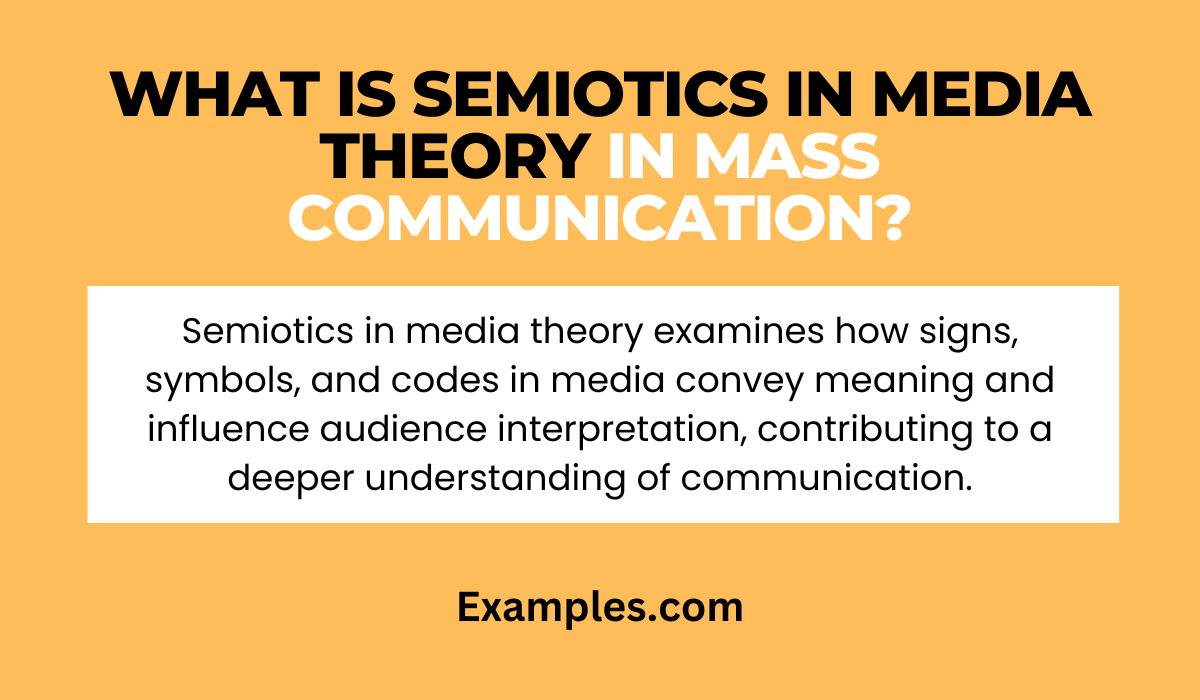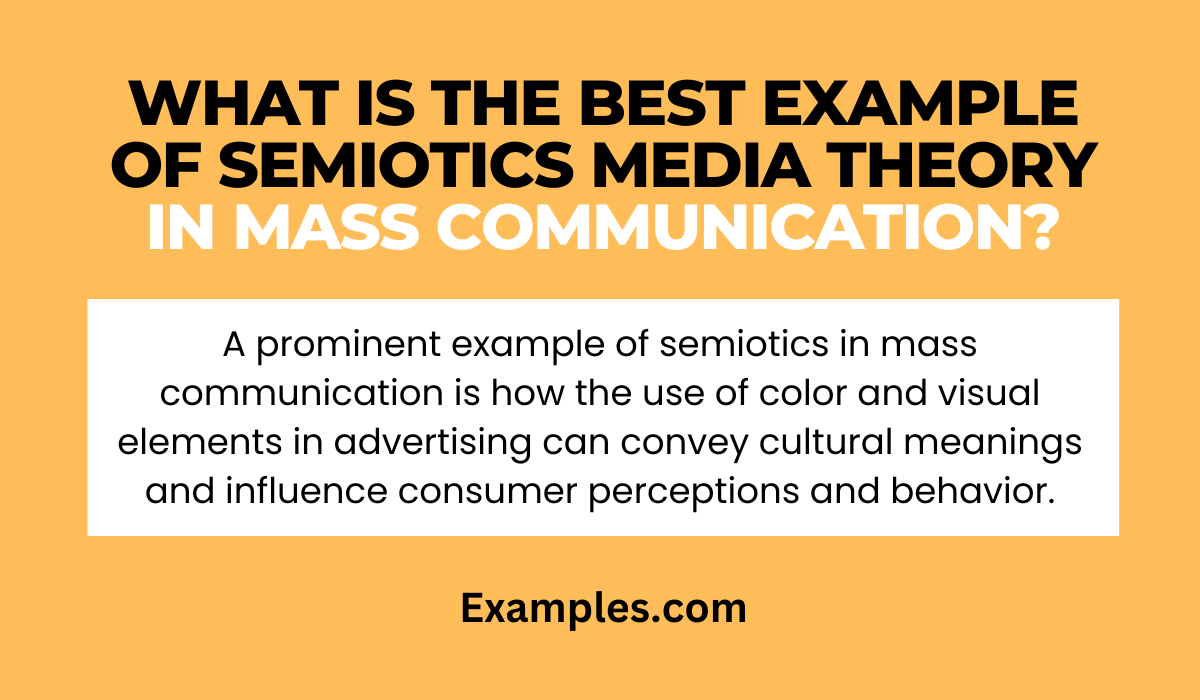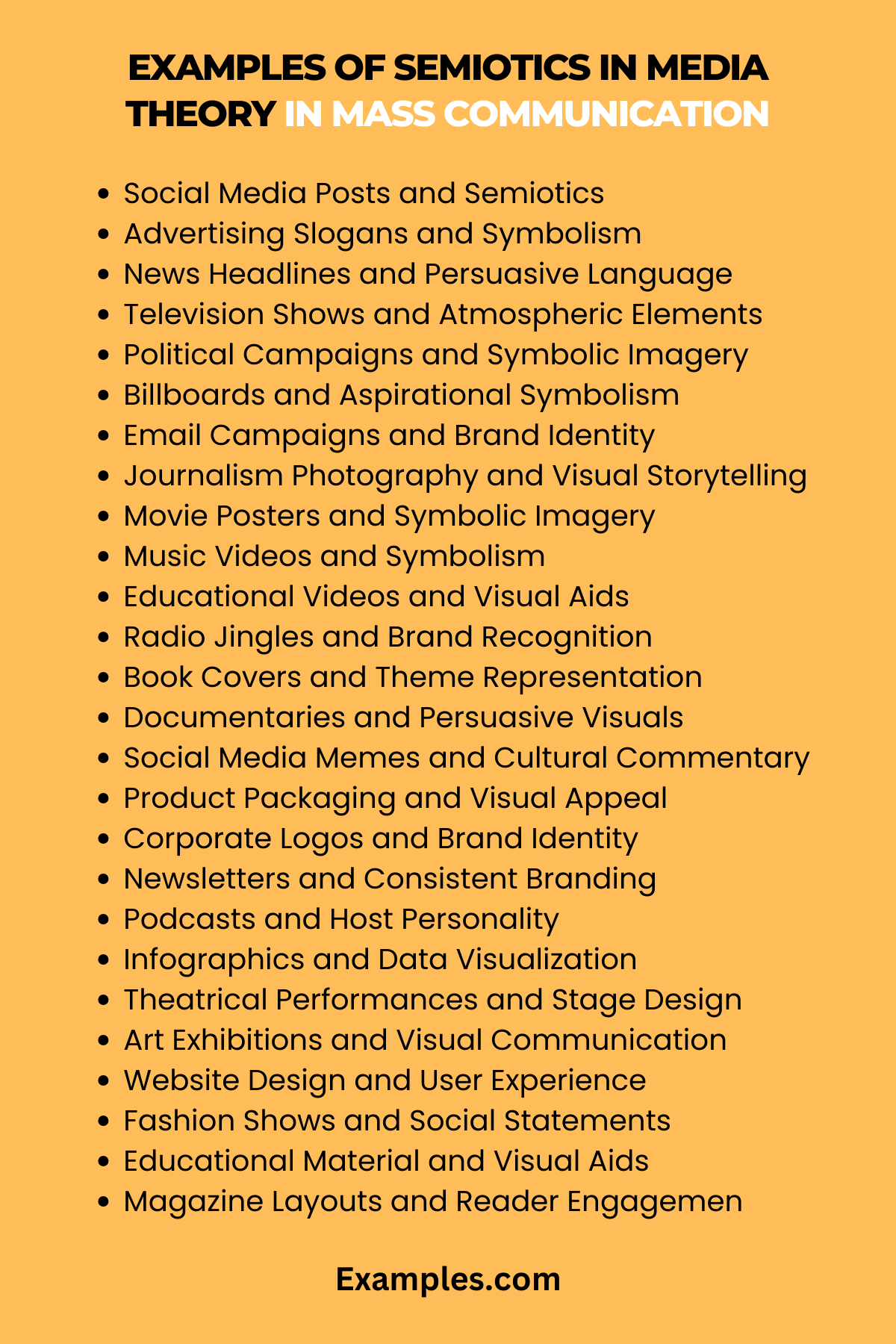29+ Semiotics in Media Theory in Mass Communication Examples
Semiotics in Media Theory in Mass Communication is a fascinating exploration of how signs and symbols shape our understanding of media. This comprehensive guide delves into the intricate world of semiotics, offering invaluable insights for students, professionals, and enthusiasts of Mass Communication. From practical examples to theoretical frameworks, this guide illuminates the role of semiotics in shaping media narratives and audience interpretations. Whether you’re studying journalism, advertising, or broadcasting, understanding semiotics is key to unlocking deeper meanings in media content.
What is Semiotics in Media Theory in Mass Communication?
Semiotics, in the realm of Mass Communication, refers to the study of signs and symbols as a significant part of communication. It’s about understanding how meaning is created and interpreted through various media forms, from television to social media. This theory examines how images, texts, sounds, and other elements convey messages, influencing the audience’s perception. Understanding semiotics is crucial for anyone engaged in creating or analyzing media content, as it offers a deep dive into the subtleties of communication that shape our world.

History of Semiotics in Media Theory in Mass Communication
Semiotics, the study of signs and symbols and their use or interpretation, has a profound history in media theory within the realm of mass communication. This interdisciplinary study originated from the works of linguists like Ferdinand de Saussure and Charles Sanders Peirce in the early 20th century. Saussure introduced the concept of the sign, consisting of the signifier (the form of the sign) and the signified (the concept it represents). Peirce expanded this by introducing the triadic model, which included the representamen (the form), the object (to which the sign refers), and the interpretant (the meaning derived by the observer).
As mass communication evolved, semiotics became crucial in understanding how media messages are constructed and interpreted. Media texts, whether in Journalism Mass Communication or Broadcasting Mass Communication, are replete with signs that audiences decode. The evolution of digital media has only amplified the significance of semiotics, making it central to analyzing how meanings are constructed and disseminated in our media-saturated society.
What is the Best Example of Semiotics Media Theory in Mass Communication?
One of the best examples of Semiotics Media Theory in Mass Communication is the use of semiotics in advertising. A detailed example is the iconic “I ❤️ NY” logo. Here’s why it’s a great example:
- Simplicity and Symbolism: The logo uses simple symbols – a heart and letters. The heart symbolizes love, while ‘NY’ is universally recognized as New York. This simple combination conveys a powerful message of love for New York.
- Cultural Resonance: The logo taps into cultural and emotional associations with New York City, evoking feelings of admiration and belonging among viewers.
- Global Recognition: The logo transcends language barriers, making it universally recognizable. This global appeal is a testament to the effective use of semiotics in mass communication.
- Versatility: The logo’s design is versatile and has been adapted in various formats, demonstrating the flexibility of semiotic elements in media.
- Longevity and Impact: Decades after its creation, the logo remains relevant and impactful, showcasing the lasting power of well-executed semiotic strategies in mass communication.

30 Examples of Semiotics Media Theory in Mass Communication
Semiotics in Media Theory is a fundamental concept in mass communication, examining how signs and symbols shape our interpretation of media messages. It delves into how meaning is constructed and understood in mass media, playing a pivotal role in shaping public opinion and cultural norms. This theory is crucial in understanding the impact of media in our daily lives, particularly in the realms of advertising, journalism, and social media communication.

- Social Media Posts: A celebrity posts a photo wearing a particular brand, subtly influencing viewers. This is an example of semiotics in social media, where images act as signs promoting consumerism.
- Advertising Slogans: A famous beverage ad uses the slogan “Open Happiness.” This phrase symbolizes joy and relaxation, associating these feelings with the product.
- News Headlines: A headline reading “Nation in Crisis” uses specific wording to evoke a sense of urgency and importance, impacting how the audience perceives the situation.
- Television Shows: In a crime drama, dark lighting and ominous music are used to create a tense atmosphere, guiding the audience’s emotional response.
- Political Campaigns: A political party uses a dove as their symbol, signifying peace and harmony, influencing public perception.
- Billboards: An oversized billboard in a busy city, displaying a luxury car, symbolizes status and wealth, appealing to viewers’ aspirations.

- Email Campaigns: Marketing emails use specific colors and fonts to create a brand identity, influencing how recipients perceive the message.
- Public Relations Statements: A company issues a statement with carefully chosen words to shape public opinion during a crisis.
- Journalism Photography: A news photo captures a moment of triumph or despair, conveying a story beyond words.
- Movie Posters: A poster shows the main character in a dominant pose, symbolizing power and setting the tone for the film.
- Music Videos: Symbolic elements in music videos add layers of meaning to the lyrics, enhancing the audience’s understanding.
- Educational Videos: Animated characters in an educational video simplify complex topics, making them more accessible.
- Radio Jingles: A catchy jingle on the radio becomes synonymous with a brand, embedding itself in listeners’ memories.
- Book Covers: The cover of a novel uses imagery and typography to hint at the story’s theme, attracting readers.
- Documentaries: Documentaries use real footage combined with narrative to present a persuasive argument or viewpoint.
- Social Media Memes: Memes use humor and cultural references to comment on social issues, resonating with a broad audience.
- Product Packaging: The packaging of a product uses colors and designs to convey its quality and appeal to specific demographics.
- Corporate Logos: A company logo embodies the brand’s values and mission, becoming a recognizable symbol.
- Newsletters: A newsletter uses a consistent layout and style to establish credibility and familiarity with its readers.
- Podcasts: The tone and style of a podcast create a unique listening experience, conveying the host’s personality and message.
- Infographics: Infographics combine text and visuals to make complex data easily understandable.
- Theatrical Performances: Stage settings and costumes in a play contribute to storytelling, enhancing the audience’s immersion.
- Art Exhibitions: Artwork in an exhibition conveys messages through visual elements, inviting interpretation.
- Website Design: A website’s design elements like layout, color, and font style dictate the user experience and brand perception.
- Fashion Shows: Fashion designs communicate cultural and social statements, reflecting contemporary trends.

- Educational Material: Textbooks use diagrams and illustrations to complement and clarify written content.
- Magazine Layouts: The layout of a magazine influences how readers engage with the content, guiding their focus.
- Gaming: Video games use visual and auditory cues to create immersive worlds and narratives.
- Mobile Apps: App icons are designed to be instantly recognizable, representing the app’s function and brand.
- Interactive Exhibits: Interactive exhibits in museums use sensory elements to engage visitors, enhancing learning and experience.
Role of Semiotics in Media Theory in Mass Communication
- Construction of Reality: Semiotics helps in understanding how media shapes our perception of reality. Media, through a selection of signs and symbols, constructs a version of reality that audiences negotiate with their experiences and knowledge.
- Cultural Interpretation: Different cultures interpret signs differently. Semiotics in mass communication aids in analyzing how cultural contexts affect the interpretation of media messages.
- Media Literacy: Understanding semiotics is key to media literacy, allowing audiences to critically analyze and understand the underlying messages in media content.
- Advertising and Branding: Semiotics plays a critical role in Mass Communication in Advertising. Brands use signs and symbols to create associations and emotional responses in consumers.
- Political Communication: Political messages are often laden with semiotic content, where symbols (like flags or colors) play a key role in conveying ideologies and rallying support.
- Narrative Construction: In storytelling, whether in films, news, or digital content, semiotics helps in constructing narratives that resonate with audiences, using symbolic elements to create deeper meanings.
- Identity and Representation: Media uses semiotics to represent different identities, be it gender, race, or class, influencing how these identities are perceived in society.
- Technological Influence: With advancements in technology, the semiotics of digital and social media, like emojis or memes, have become an integral part of how we communicate and understand messages.
Semiotics is a vital tool in media theory, providing deep insights into how mass communication works. It helps decode complex media messages, making sense of the symbolic world we navigate through different forms of media, from traditional Broadcasting Mass Communication to dynamic digital platforms. Understanding semiotics is not just an academic exercise but a necessary skill in the age of information overload, where interpreting signs correctly can mean the difference between miscommunication and clarity.
Importance of Semiotics Media Theory in Mass Communication
Semiotics, the study of signs and symbols and their use or interpretation, plays a pivotal role in Mass Communication. It helps in understanding how media content conveys meaning and influences the audience. Here are key points illustrating the importance of Semiotics Media Theory in mass communication:
- Decoding Messages: Semiotics enables us to decode complex messages in media. It breaks down how images, texts, and sounds convey specific meanings to audiences.
- Cultural Interpretation: Different cultures interpret symbols differently. Semiotics helps in understanding these cultural nuances in mass communication, ensuring messages are culturally appropriate and effective.
- Enhancing Effectiveness: By understanding sign systems, media professionals can create more engaging and effective communication strategies.
- Analyzing Trends: Semiotics aids in analyzing current trends in media, providing insights into how society interprets and interacts with various media forms.
- Media Literacy: It fosters media literacy among audiences, empowering them to critically analyze and understand media content beyond the superficial level.
How to Use Semiotics in Media Theory in Mass Communication
Using Semiotics in media theory involves a detailed process of analyzing and creating media content. Here’s how it can be done effectively:
- Identify the Signs: Start by identifying the key signs (words, images, sounds) in a piece of media content.
- Understand the Denotations and Connotations: Analyze the literal meaning (denotation) and the implied or associated meaning (connotation) of these signs.
- Contextual Analysis: Consider the context in which the media is produced and consumed. Context greatly influences how a sign is interpreted.
- Audience Interpretation: Understand your target audience’s cultural background and how it might influence their interpretation of the signs.
- Integrate Theory with Practice: Combine theoretical knowledge with practical media production. Use semiotic analysis to guide the creation of media content that conveys the intended message effectively.
- Feedback and Revision: After disseminating the media content, gather feedback on how the audience interpreted the signs and make necessary revisions for future communications.
Semiotics Media Theory plays a crucial role in understanding the dynamics of Mass Communication. This theory delves into how meaning is created and interpreted in media texts, be it in journalism, advertising, or digital media. By analyzing signs and symbols, Semiotics Media Theory offers a deeper insight into how messages are conveyed and received in various forms of communication.



